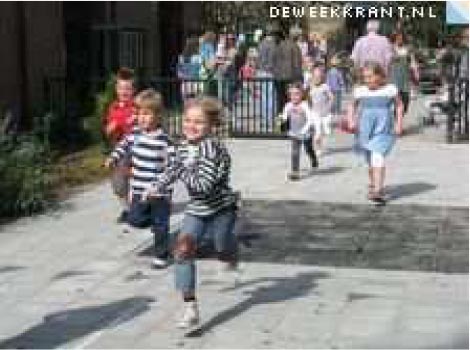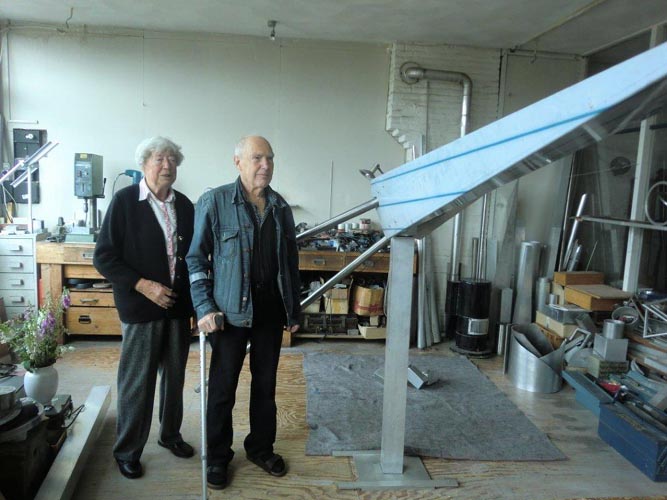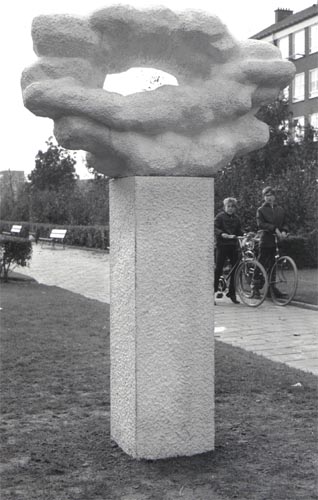

|
Beste lezer, Wicher Meursing fantaseerde in de oorlog, dat hij met een fiets dynamo, met een gewicht wat van het dak naar beneden zou hangen, dat hij in die tijd elektrisch licht kon opwekken en een elektrische fiets zou maken. Lees meer over deze eigenzinnige beeldhouwer in zijn interview aan QUO Magazine. |
 Wicher Meursing |
Dear reader, Wicher Meursing fantasized, during the war, that he would be able to generate electricity by hanging a dynamo with a weight, from the roof, and then he would use it to make an electric bike. Read more about this willful sculptor in his interview to QUO Magazine. |
||||||||||||||||||||
|
 Rosa Bela Cruz  Álvaro Leite de Vasconcelos  Peter Voerman |
|
||||||||||||||||||||
|
De beweging die we kunnen waarnemen, de mentale beweging, de schijn beweging,… Iedereen heeft daar verschillende ideeën over. Elke pagina van deze editie laat er een ander concept zien. Laat je mee voeren door de beweging en geniet ervan! De september/oktober editie van QUO Magazine verschijnt op 29 augustus met het thema: “Inspiratie” Teresa Pinto Reageren: info@quomagazine.nl |
The movement that we can observe, de movement in de mind, de apparent movement… Everybody has a different idea about it. Each page of this edition shows a different concept. Go with the flow and enjoy! The September/October issue of QUO Magazine will be online August 29th with the topic: “Inspiration” Teresa Pinto Reactions to: info@quomagazine.nl |
|||||||||||||||||||||
|
||||||||||||||||||||||
|
On the Move Mo Haan |
||
|
This edition’s theme on “movement” made me think about moving through life, figuratively and literally speaking…and the occasions in which these two seem to merge, such as with travelling. My thoughts went back to my travels through Australia and more recently, to NYC, where I met a documentary filmmaker. She was doing a project on people (and herself) feeling dislocated. She was travelling around the world, interviewing people who somehow felt they didn’t belong in the places they lived (mostly foreigners living abroad for all sorts of reasons; political, economical, matters of the heart…). She put the interviews on her blog and once back home in Amsterdam, I started reading them. They inspired me to write about my own feelings of being dislocated at times. This is what I wrote: “My trip to NY, by myself, was the most relaxing trip I ever had- and that for a busy city like NY. I felt at home. Ok, I stayed in the relatively quiet neighbourhood of Chelsea, in a lovely hotel in a room facing the backyard and everything was fabulous. But there’s more to it than that. It dawned on me that NY may be a good place for me to be, but the bottom-line is that at this point in my life I feel pretty much at home with myself. It determined my contacts with other people in NY; I felt connected while taking my own pace, which made me happy. It has not always been like this. Being able to feel more connected to myself, other people and the world surrounding me, has been a process of letting go and learning just “to be” more. Eight years ago I traveled through Australia for 6 months. I left Amsterdam feeling dislocated. I felt I didn’t leave much behind; I was in between jobs, in (and out) of a confusing relationship, and friends appeared to be more my ex’s than mine. |
It felt good to make new friends in Oz, people that appreciated me for me; the liberating fact of just being you without a past. At the same time, being so far away from home, I realized my strong connection to my family and friends, which I had more or less taken for granted. Also, in maintaining in touch with my friends at home, I discovered who were good friends and who weren’t. I did leave a lot behind. My confusing relationship traveled with me, from day one to the last, sometimes haunting me with a longing I wished I did not have. It became obvious that by leaving the country, I wasn’t able to just remove it from my luggage at the check-in. However, beautiful people, surroundings and experiences put my life in a new perspective. I felt happier, more confident and got to know me better. Travelling may be either an attempt to get away from yourself, to find yourself, or both. I believe it’s (just) a way to live your life; at that particular moment it ís life. I noticed, looking back on both trips, that by being away and literally distancing myself, I not only got a new perspective, but a clearer perspective on me and my life.” And now, reflecting on these words, it makes me wonder….I’m seriously considering going back to Australia for a while. As a matter of fact, I have done that ever since I got back. It hasn’t happened yet due to different sets of priorities. But truly, at the same time I was also struggling with my motivation for wanting to go back. Was it for sentimental reasons? Is this really me or was I running away from my life here and thrill seeking? What would be the purpose of my travels now? I think I’ve come to terms with these doubts and judgments, ever since I heard someone say that he was travelling for two reasons: because he enjoyed it and it was really like him, ánd it was an escape at the same time. Beneath my doubts and judgments lies fear. Like I said, travelling is just life, the only difference is that you’re not at home! I am who I am nów, and that’s the one I’m taking with me when I go. |
|
|
Tarot: de Zon Petra Stam |
||
 Op de kaart is een kind te zien dat een tuin uitrijdt. De muur van het verleden geeft oude beperkingen aan, maar die worden achtergelaten. Natuurlijk zijn er nog wel grenzen, maar die vormen geen belemmering meer om eenheid te ervaren. Dit geeft nieuwe inzichten in de realiteit. Het paard laat zien dat er een enorme energie is. Het kind heeft geen moeite om het dier te berijden, wat aangeeft dat het één is met zijn dierlijke instincten. De enorme zon zet alles in een helder licht, waardoor je niet meer zoekt maar vindt.
Op de kaart is een kind te zien dat een tuin uitrijdt. De muur van het verleden geeft oude beperkingen aan, maar die worden achtergelaten. Natuurlijk zijn er nog wel grenzen, maar die vormen geen belemmering meer om eenheid te ervaren. Dit geeft nieuwe inzichten in de realiteit. Het paard laat zien dat er een enorme energie is. Het kind heeft geen moeite om het dier te berijden, wat aangeeft dat het één is met zijn dierlijke instincten. De enorme zon zet alles in een helder licht, waardoor je niet meer zoekt maar vindt.Het kind staat voor onschuld en wijsheid. Kinderen staan dicht bij de bron van het leven. Als je je innerlijk kind koestert kun je je eigen verbinding met de wereld om je heen beter voelen. De Zon laat je eenheid ervaren, geeft vreugde, energie en ruimdenkendheid. In het licht wordt alles helder en duidelijk, en kun je de kern van de zaak zien. De kaart geeft aan dat er groeimogelijkheden zijn. Het zijn kansen om te zijn wie je bent! Durf naar je diepste innerlijk te te luisteren. Want om te groeien is het belangrijk dat je trouw bent en blijft aan jezelf. Geniet van de zonnige kant van het leven, die kant waar we hopelijk ook letterlijk van kunnen genieten de komende tijd (als het weer het toelaat), wees optimistisch en daadkrachtig. Zie wat je mogelijkheden zijn en op welk vlak je verder wilt groeien. Dit is de tijd dat alles in het licht staat en dat je een licht kunt werpen op jezelf en je diepste wensen of verlangens. |
||
|
In het licht van de Maan handboek vieringen, symboliek en bewustwording |

|
Petra Stam en Marja de Zeeuw 21 x 22,8 cm fc, geïllustreerd, 192 pagina's verschijnt begin augustus 2011, maar is al wel te bestellen omvang en prijs onder voorbehoud ISBN: 978 90 77408 00 1 NUR: 728 € 29,50 bestellen |
|
De Maan trekt aan het water van zeeën, oceanen, mensen, dieren en planten. Zelfs bergen zijn een paar millimeter hoger als de maan boven hun toppen staat. Haar schijngestalten geven de eeuwige cyclus van het leven aan: creatie, groei, afbraak, dood en wedergeboorte. Ze inspireert kunstenaars, trekt aan de harten van geliefden en brengt ons via dromen, emoties en gevoelens in contact met ons onderbewustzijn. In dit boek laten Petra Stam en Marja de Zeeuw zien hoe je op je eigen manier kunt stilstaan bij de kracht van de Maan. Hoe je die kracht bewust in je leven kunt inpassen om dichter bij je gevoel, intuïtie en onderbewuste processen te komen en zo de doelen binnen je eigen cyclus te bekrachtigen en beïnvloeden. Om binnen de zonnecyclus de maancycli te kunnen betrekken, hebben ze dertien volle manen binnen het kalenderjaar geplaatst. Elke volle maan heeft een eigen hoofdstuk gekregen met onder meer aandacht voor thematiek, historie, astrologie, tarot, mythologie, symboliek, rituelen, jaarfeesten, bomen en de elementen. Verder bevat elk hoofdstuk vele praktische suggesties, de maankalender en recepten voor thee en wierook. Dit handboek vertelt je niet wat je wel en wat je niet moet doen, maar stimuleert je iedere volle maan bewust stil te staan bij de thema’s die in de natuur spelen, je eigen ervaringen op te doen, je zelf verantwoordelijk te voelen voor je besluiten en acties, en dus bewust te worden van jezelf. Kortom: het stimuleert je op zoek te gaan naar je eigen waarheid. auteurs e.a. |
|
 Petra Stam Petra Stam
|
Marja de Zeeuw 
|
|
Doodstroom Petra Stam |

|
Renata Rosa’s Encantações Marcos Moraes |
||||||
|
Back in the late seventies, Brazilian songwriters Aldir Blanc and Mauricio Tapajos released “Querelas do Brasil”, whose motto sings “O Brasil não conhece o Brasil” [Brazil does not know Brazil]. With some variations, this re-appears, as the song goes on, as “O Brasil não merece o Brasil” [Brazil does not deserve Brazil], and “O Brasil nunca foi ao Brasil” [Brazil has never been to Brazil]. It was tacit then that those songwriters, under the political autocratic regime we were going through [1964-1985], were expressing metaphorically a general feeling about that situation, but the complaint was mainly and more explicitly aimed at something that applied then as it applies now: a cultural phenomenon. Namely, the fact that, then and now, we sure were and are proud of our music and musicians. We knew and know (maybe not enough yet!) that Tom Jobim, not to mention many others, was acknowledged as one of the great songwriters in the world. Samba, Bossa Nova in particular, had and continues to hold a place in the universal musical canon. What, then, were Blanc and Tapajós complaining about? Though the answer might not be that simple, one thing, for sure, can be considered as an important part of it. This is the fact that if on the one hand Bossa Nova actually is representative of our culture, on the other hand it does not quite represent the whole of this continental country. There is something else that – then as now – is left aside. Under labels such as World Music or “ethnic culture” (and there certainly will be other places and opportunities to critically discuss these labels) North-Eastern Brazil`s culture and – more specifically – music is that something which, despite its richness, is, so to speak, left aside. There might even be valid arguments showing that things were as they should be. But this would never justify stagnation (let alone any kind of ‘resentment` feeling). Be what it may, this scenery demands action, interest, labour, and passion. And that`s what brings us to Renata Rosa. Brazilian singer, songwriter whose work is still more familiar to a specific audience in Europe then to Brazilians, Renata`s two Albums (see below) are strongly ` idiomatic` in the sense that they are not Brazilian mainstream popular music, which at a first glance is a paradox, considering that Renata is a typical middle-class educated ‘paulistana’ as we call those born or brought up in São Paulo Town. A closer look at Rosa`s life history may help us here. Cosmopolitan São Paulo has a 27.000 inhabitants neighbourhood called Brás (not named after “Brasil”, by the way). That`s where Renata Rosa spent her early youth. Though specially multi ethnic, it is a well-established fact that Brás was the area Italian immigrants first settled in that town. Thus, it would be only natural to think that, on top of being an urban South-Eastern Brazilian, Renata – not being a typical main-stream Brazilian musician - might have some kind of italianized bias. This is not the case, though. Renata Rosa, contrary to Blanc & Tapajó`s insight, is, by all means, one of those who “know Brazil”, who “have been to Brazil” – who “deserve & are deserved by Brazil”. Yet, a question still remains, as we`ll see: Does Brazil actually want to know Renata Rosa? In order to sketch out some answers here, we`ll use the concept of layers. Layers, not only in its more colloquial and less complex acceptation but also meaning things like layers of culture(s), of an individual consciousness; layers of reality. And though one may be led to think of layers in hierarchical terms – such as upper layer versus lower layer or surface layer versus deeper layers - we should try to keep in mind that things are less stiffly organized and more dynamic in such a way that, contrary to common sense, two or more layers may occupy the same “space” and “ time”; they may be interwoven, may communicate with one another and still be layers. Think of the winds, of dreams, certain kinds of carpets or mantles…. those may eventually fly; countries that “have never been to or in themselves”, chants that have ever been there….. So, to begin with, let`s have a look at one of Renata Rosa`s layers, namely, Rosa`s formal, institutional, studies. From 1992 to 1998, at Universidade de São Paulo (USP) Renata studied and graduated in Literary Studies and also in fonoaudiologia [sung and spoken voice therapy]. Partially parallel to this - 1995 to 2000 - she completed her musical studies – Singing (popular and classical) – at Universidade Livre de Música Tom Jobim, a college-like institution that, with some provisos, might represent to Brazil that which Berklee College represents to the USA. Besides attending regular university/college courses, Renata was an active member of the Núcleo de Estudos da Voz [Voice Study-Research Group], at USP, from 1997 to 1998. And…. there it is! A perfect candidate to becoming a 21st Century Bossa Nova musician-singer. However, this would be so only if we ignore other layers. Brás – the SP neighbourhood – has, besides the traditional Italian layer, the “nordestino” layer. The people and culture from North-Eastern Brazil who migrated to São Paulo (Renata migrated to Pernambuco in 1998). This will make a decisive difference. According to Renatas`s own recollections, what strongly grabbed her attention was the “nordestino” poetical and musical practices she plunged in at Brás streets. That is: the “cantorias de viola” where Jousts – just like the medieval minstrels – were carried on. Jousts (desafios) where improvised sung verses were ‘thrown’ from one to another player to the sound of the “viola” [plucked string guitar-like instrument]. Again according to Renata`s words, not the music itself, but the improvised lyrics fascinated her at first – no wonder her first university degree was Literary Studies. But the music – the chants – has been always there, shining towards unconscious layers. The typical rhythms and that most peculiar sound achieved when the melody is based on a scale you can produce by playing C D E F-SHARP G A B-FLAT C All this was there as they are in many of Renata`s songs. (as we will see in a moment)
Moreover: previous to Renata`s encounter with her “rabeca” [her bowed nordestino string instrument – a kind of fiddle], there came the rural religious chants and Brazilian Indians music. Among the many features that so impressed Renata Rosa there was what she describes as something she could not find at school, namely, the sinuous turns always present in those melodies.
The second layer, (2008) shows an artist – and less of a researcher – with already visible synapses being built towards the into-Brazil-elsewhere already mentioned here. It is called Manto dos Sonhos, an expression I`ll freely explain as the layer (or mantle) of the dreams.
Other fiddler,
As for the third one we can already peer into it. Its name Encantações is a neologism, a semantic cluster uniting several layers:
ENCANTAÇOES |
||||||




























